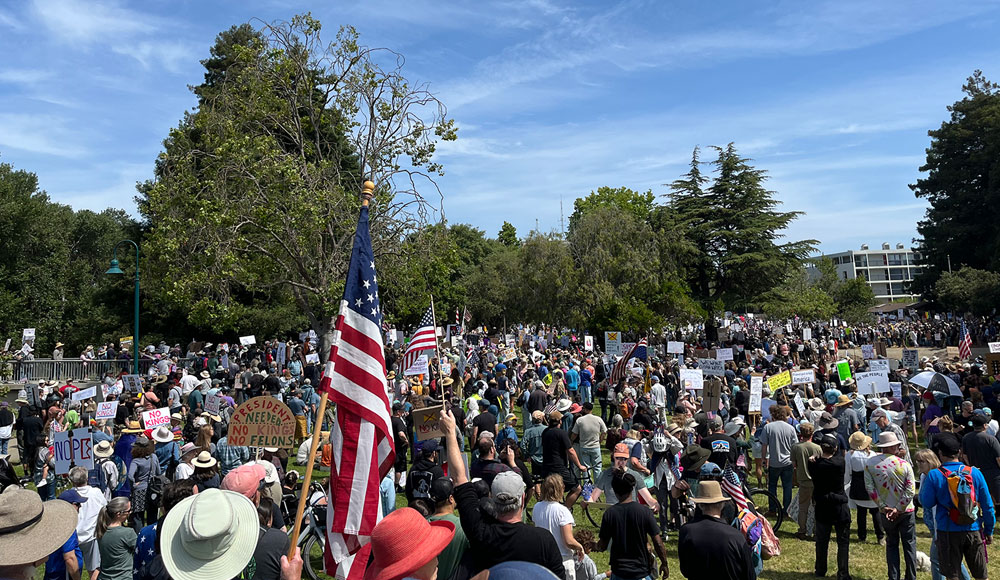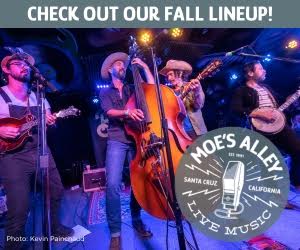I was born in the deep south, Bakersfield. On April 19 I drive to the reddest of red California, to cover a Kern County Hands Off rally in my hometown. Most of them have never protested before.
“What are you protesting for?”
David Wescott, 41, puts his hands on his children’s heads and says, “For them.” He stands with his wife and kids and holds a Veterans Against Trump sign. His hair is cut in a high fade, muscles fill out his green U.S. Marine T-shirt. He deployed to Kuwait in 2003 in support of Operation Iraqi Freedom and is now finishing law school with a specialty in constitutional law.
“So, David, how is our constitution holding up?”
He exhales, his shoulders slump. “I feel bad for my professors in constitutional law because right now our constitution is going through significant challenges.”
He looks into the distance. “You know, these laws are things that have precedence over hundreds of years. These are the pillars of our democracy.”
I’m glad one of our best will keep track of our constitution, because all I see is a Supreme Court that has voted itself out of existence.
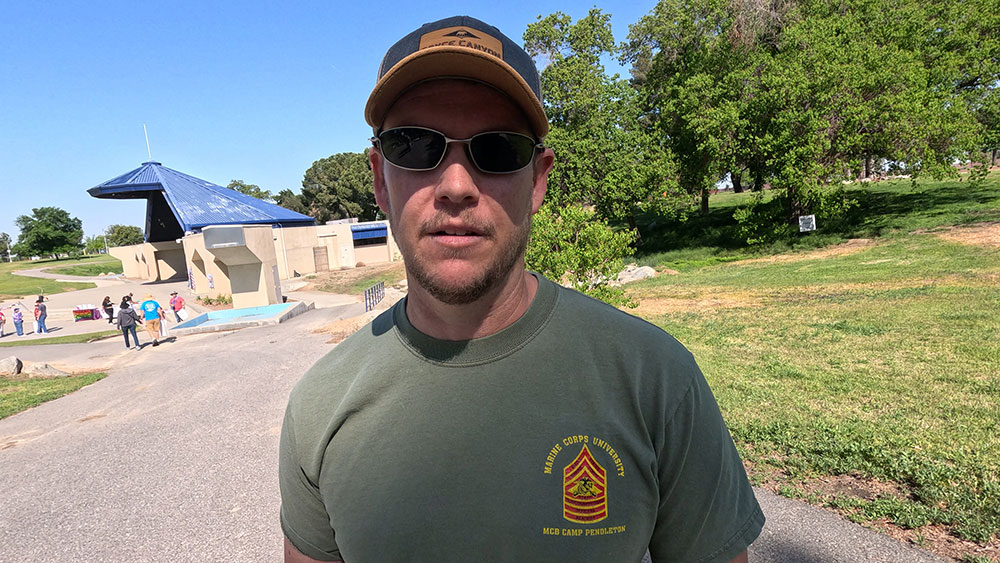
I ask David, “If Trump tries to use the military to take over, what would the Marines do?”
He tells me that active military members are having that conversation now. “Our oath is to the constitution, not the president. Seventy-five percent of the Marine Corps are 22 and younger, most haven’t formed much of a world view yet, so they will be looking to their immediate superiors for what to do. They would start with their lieutenant, who has direct access to upper leadership. Leadership in the field will decide how it will go.”
“OK, but what if the commander in chief orders them to round up journalists or Mexicans or gays, to shoot us?” I ask.
“I think if it becomes that blatant, that we’re rounding up marginalized groups of people, I think there would be a huge problem in the military for that.”
Jon, 42, an Oildale schoolteacher, started protesting because of his students whose parents are not citizens.
“The kids are citizens. But their parents get deported and then there’s no one to care for these children.”
“This happens in your class? To your students?”
“Yes.”
I ask Jon, “What does protesting do for you?”
“It makes me feel better. To some degree it keeps me sane. And maybe this gets us in gear for the midterm election. I believe we still have a chance to save democracy.”
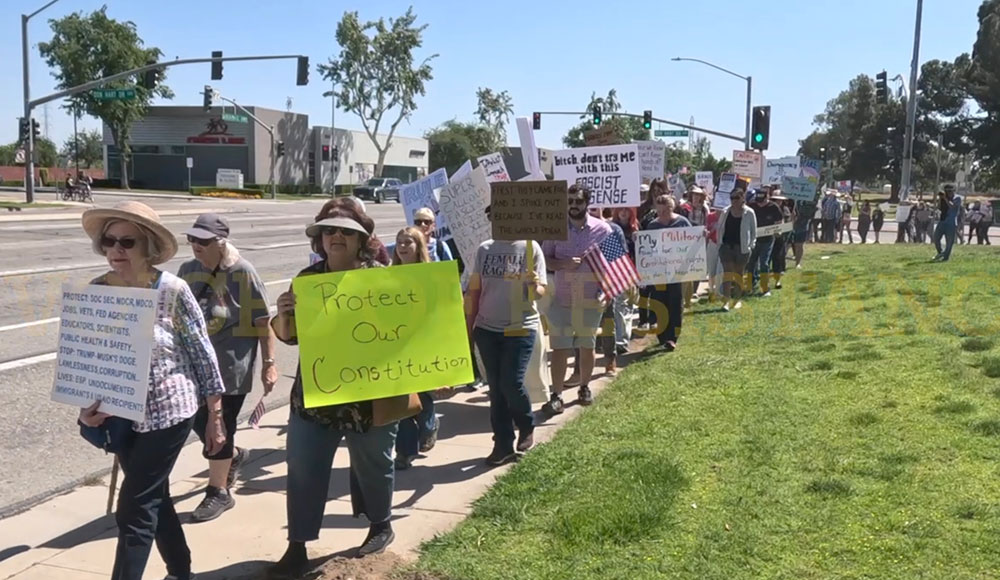
including this one at State Park Drive. PHOTO: Brad Kava
Community of Resistance
Why a person decides to protest can be intensely personal. Bakersfield Hands Off volunteer Lindsay, 42, is the mother of two autistic children. She had never protested before but felt piqued when Robert F. Kennedy, Trump’s secretary of Health and Human Services, said that autistic children put a burden on their families that will destroy them. Lindsay’s eyes well up as she says, “Regardless if you’ll ever pay taxes or if you’ll ever have a job or if you’ll ever get married or write poetry, all the things that Kennedy said autistic kids will never do, a lot of them will. But even if they can’t, it does not mean that they don’t have value. That just breaks my heart.”
The New York Times reports that poet Marianne Eloise, 32, who is autistic, responded to Kennedy’s comment about autistic people being unable to write a poem. Author of many published poems and books, Eloise says, “I would love to read R.F.K.’s poetry. I’m not familiar with his work.”
Those who compare the Trump administration playbook to 1933 Nazi Germany may find traction with Marianne and Lindsay’s stories. Nazi eugenicists argued that there was a direct link between diminished capacity and societal worthiness. Eugenics provided underpinning for the murder of the institutionalized disabled in the Nazi “euthanasia” program.
“So, Lindsay, what does protesting accomplish?”
“We’re building a community of resistance to this dictatorship that is based on cruelty. The more people join us, the more we will turn Trump’s constant drumbeat of fear to empathy. We keep growing and I dream about the 2026 election.”
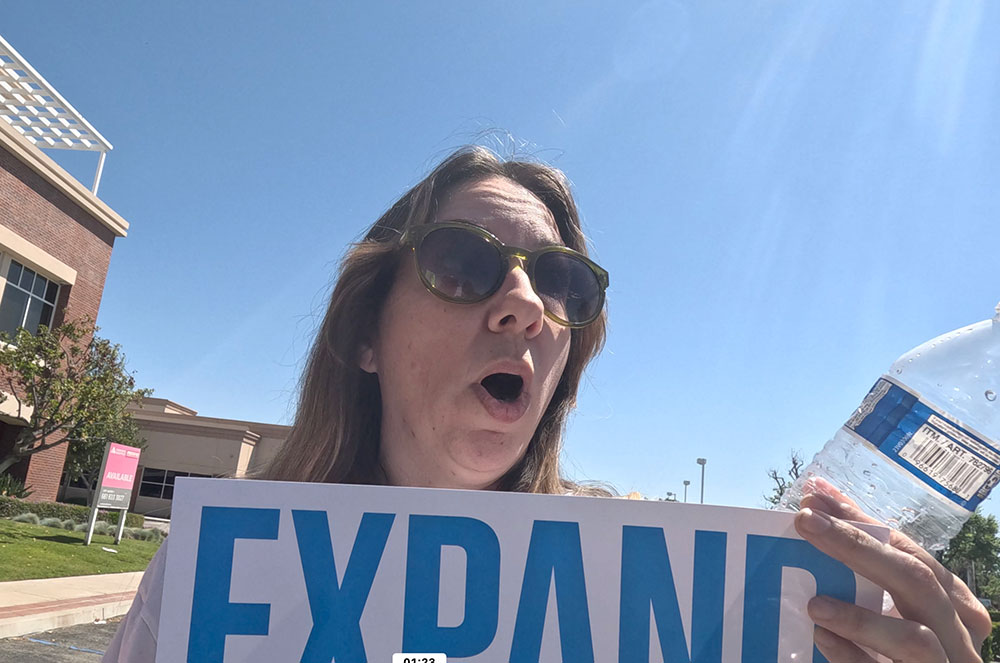
Linnette, 39, stands next to her son and husband with a sign that says, “Expand Social Security.” I ask her why a young person would march for Social Security. Linnette says she had never thought about protesting before but is scared that DOGE will cut her father’s payments. “He’s 98 and lives off this security. If they took it away, it would fall on us and we’re barely making it now. Why would anyone do this? Why?”
Her husband, Paul, 42, is a manager at Human Services of Kern County.
Paul says, “The guy who’s running Health and Human Services. We have an outbreak of measles going on and the best way to prevent a measles epidemic is a vaccine. This is insane!” Paul says he works to defend the health of the most vulnerable, but the Trump administration does not care about medical care for vulnerable people.
Many claim they protest to retain their sanity. At the April 15 Bernie/AOC “Fighting Oligarchy” rally in Folsom, I meet Carl Matranga, a grizzled, white-pony-tailed vet. His grin shows one gold and two missing teeth. Carl opens his Army jacket to reveal the words on his T-shirt, a quote from poet William Shenstone:
A liar begins with making falsehood appear like truth,
and ends with making truth itself appear like falsehood.
Matranga believes Donald Trump’s superpower is his shamelessness. He explains how Trump’s endless lying bent his head until it seemed normal.
“He lies about absolutely everything, from eggs to immigrants eating pets. It blew my mind. I started telling myself, ‘OK, politics is a dirty game. Who knows what’s true or not true? I better just stay home.’ Hearing myself say, ‘I better just stay home’ scared the shit out of me. Now, I go to every protest I can.”
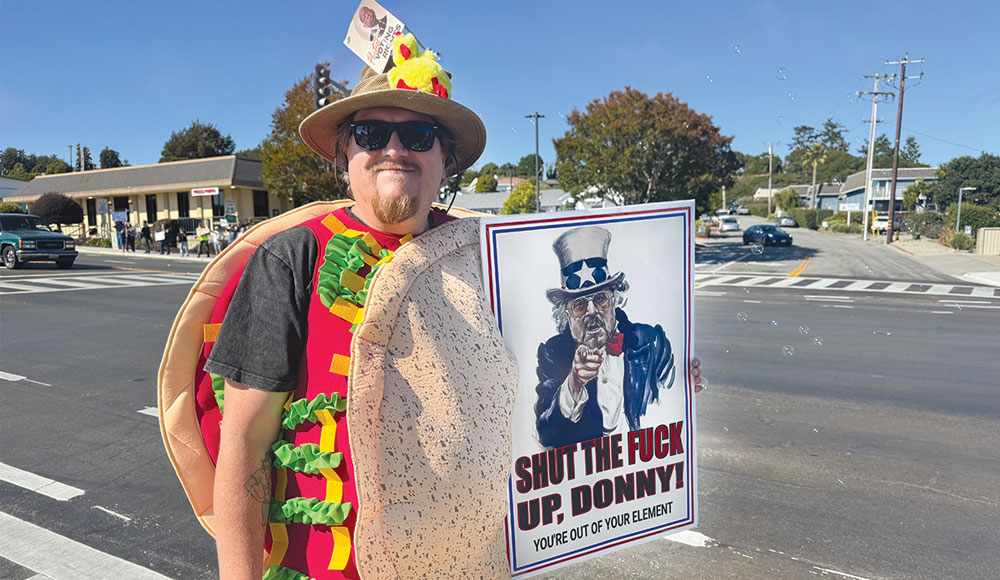
As the Folsom crowd of 30,000 starts chanting “Bernie! Bernie!” Carl shouts in my ear, “George Washington could not tell a lie. Richard Nixon could not tell the truth. Donald Trump can’t tell the difference.” He grins, fist bumps my shoulder and turns to chant with the crowd.
The generations start listening…to each other
Almost all the protesters I’d seen before June 14 were old people and their parents. It’s hardly surprising: Despair is the reality of many young folks these days. The June 14 No Kings rally, organized by IndivisibleSantaCruz.com, was the first time I saw Gen Z (ages 13 to 28) show up in mass.
A young man with long, black hair says he’s concerned about the impact of climate change on his generation, and sees older generations wage a war on youth. “We are castaways on the older generation’s unrelenting march toward greed.” He says there is nothing to do but take to the streets. “At least older people here pay attention. What will protesting change? Maybe us. Maybe galvanize us to stand up for a future we can live in.”
I point out to a young, red-haired man named Kyle that, until today, most protesters have been geezers like me. Kyle says, “Yeah, I’ve noticed that. It might simply be experience. The older generations have seen the kind of movement that is necessary to push back against political tyranny.”
Caroline Bliss-Isberg, 85-year-old Indivisible volunteer and lifelong activist, agrees with Kyle about seniors bringing experience to the anti-Trump resistance.
“We have watched America’s better angels in action when attacked and we are willing to do what we are still able to do to keep them aloft.”
At the Bernie/AOC rally in Folsom I meet an effervescent Sacramento State University student who formerly worked in the Santa Cruz planning department, where he saw people who weren’t able to afford housing.
“That was my entry point. I was interested in the housing element, but when the election happened in November and I saw Trump move to gut education, what had been a clear system in my classes of what was going on, is now like, no one seems to know what’s happening.”[1]
Lizzy Sterling of Santa Cruz, 20, says she feels that it’s important to not judge those who haven’t gotten involved, but rather to encourage them to. Sterling says, “Personally, I have been involved in the local music scene, which is rooted in a lot of progressive thinking, community involvement and fund raising for issues we believe in.”
An anonymous 20-year-old says, “How am I supposed to go out and be the face of the movement when I feel like old people are constantly saying we’re stupid and don’t know anything?” She says that the worst for her is to see young people who are behind the dictatorship. “That’s what makes me feel bleak about the future. Some young people are going really, really conservative in a scary way.”
Seniors, still protesting after all these years
Many protesters at anti-Trump rallies are seniors, often the same people who protested the Vietnam War in the ’60s. My son teases me that I could get my Vietnam war signs out of the attic and recycle them.
Bliss-Isberg, the 85-year-old Indivisible volunteer, agrees that it[2] feels recycled. “But this time feels worse. Chief among our reasons to be here is the sense of urgency we elders feel. This is the first time in my life that our national values are under existential threat. The only way to stop this is for people to stand up.” She thinks hanging the flag upside down is defeatist, it means danger. She wants to reclaim the flag.
“Protesting works. If three percent of the people show up, something happens. The Tesla takedown worked. My biggest fear is not being courageous enough to stand up for what I believe in.”
Indivisible volunteer Sandy Silver, 86, says, “I got started protesting when I was pregnant. Sitting in my gynecologist’s office, I read a poster on the wall that said nuclear testing has produced radioactivity that is found in breastmilk. My breastmilk. I started protesting and never quit.”
She is encouraged by young folks joining the protests. “Young people have so much to do, trying to start a family, so much going. They are doing what they can.”
I ask what she would say to someone who is thinking about protesting.
“I would say, DO IT! My grandchildren range from 15 to 25 and they do it. You’re building community to fight back.”
At the Bernie/AOC rally in Folsom, I ask a white-haired man wearing fit-over sunglasses, “Do protests matter?”
“Oh, absolutely. You get to see your neighbors and friends, and people in the community come together for a common goal, which you wouldn’t normally see if you just lived in your own house and watch it on TV. It makes us feel united.”
Donald Trump: ‘Can’t you just shoot them?’
When I ask longtime activist Marla Gomez, 72, if protests give Trump cover to intensify a crackdown, Marla laughs.
“He hardly needs an excuse. He will lie about the need to crack down and just do it anyway. His unpredictable reactions really are so predictable.”
Every protester I meet agrees that protests must be nonviolent. New York Times columnist David Brooks pointed out on the PBS NewsHour’s April 25 broadcast, “One of the ways that authoritarians lose control is when their opponents protest in a nonviolent way, and the authoritarians crack down violently. That’s the way you delegitimize an authoritarian regime.”
Indivisible Santa Cruz County, organizer of the June 14 No Kings rally in downtown Santa Cruz and the July 17 Good Trouble protests at multiple locations from Santa Cruz to Aptos, is clear that protests must be nonviolent and asks everyone to make sure no one is goaded into physical confrontation. “We expect all participants to seek to de-escalate any potential confrontation with those who disagree with our values.”
A protesting undergrad political science major at UCSC agrees: “That’s how we win. We don’t fight back, we video them when they attack us, the event goes viral, and we win the day.”
Lifetime activist June Eggers, 62, talks about sustainability of protest pressure: “You won’t be able to take on every fight. They want us to wear out; that’s why Trump ‘floods the zone’ with executive orders. Don’t take the bait, but do what you can and live your life.” She reminds me that after the Grinch had stolen all the Christmas trappings from Whoville, the Whos joined hands in a circle and sang songs. June says, “Joy is essential. Join hands and sing every day. It drives them crazy.”
10,000-plus in Santa Cruz
It’s June 14, and joining the Santa Cruz No Kings protest feels like coming home. I get lucky and find a parking space near McDonald’s and jog down Ocean Street. People pour onto Ocean from cross streets, and I’m swept along in a current of military uniforms, tie-dyed hippie garb, pride flags, expensive designer clothes, costumes from Santa to Satan, patched jean wear, rumpled cowboy hats, bowler hats, dreadlocks, mohawks, motorcycle helmets, hard hats, red-white-and-blue colored hair, thousands of signs. Everyone reads everyone’s sign and laughter rolls.
A young man plays marching rolls on a snare drum, another balances on top of a fire hydrant, urging on the crowd, “Hey, ho, Trump has got to go!” Skateboarders pump fists and flash peace signs, young women with clipboards enroll women for feminist activism. The very old walk with intention, each step of their ancient foot is like they are planting a statement. Cars crawl by, drivers join the protest with a cacophony of honking as marchers yell back to the drivers, and 18-wheelers and cement trucks thrill the crowds with long, bellowing air-horn blasts. Teens and twenty-somethings push skateboards and bikes, seniors push walkers, and moms and dads push baby carriages. There are thousands and thousands of signs.
Signs of comedy relief
There are simple signs, elaborate signs, hilarious signs. A young man skateboards down the sidewalk with a sign over his head: “Congressional Republicans, save yourselves with stem-cell research. It may be your last chance to grow a spine.”
“President Trump, how are you going to deal with Hurricane Maria?”
“Pay her what I paid Stormy Daniels.”
Two women notice they had made the same sign; they touch their signs together like clinking glasses of wine: “Free Melania!”
A child holds a sign: “Trump has a mug shot. My parents don’t.”
A man in an orange fright wig and a red clown nose wears a sandwich board depicting a cleaning product called “Voter Detergent” that “whitens” elections. I ask him what makes him worry about voter suppression. He says, “After Trump’s sycophant Robert Kennedy removes vaccinations that protect us from contagion, Trump will require mail-in ballots to have envelopes that have been licked by six people.”
We flow across the county government parking lot toward San Lorenzo Park, until we stop. Young people climb trees to make videos. I can’t see much of the Duck Pond stage, but we listen to speakers sling slogans over the crowd and the crowd roar back in call-and-response. I ask a man pressed against my shoulder how he feels. He shouts back, “I feel like we’re coal miners sent down to rescue survivors of a cave-in.”
I’m having a 1967 flashback; 58 years ago, it was LBJ and Vietnam, today it’s Dubious Caesar and his Lady of Justice Pussy Grab. I half expect County Joe and the Fish to appear to play the Vietnam Rag. “Whoopie, we’re all gonna die!”
As for my wife, Julie, it was her first protest. She says, “I did not know how hopeless I was feeling until I came here and felt hope.”
Walking back up Ocean Street, I stop at the Jury Room for a beer. I reflect that people had so much fun today, there is no doubt the protests against Trump will grow. It’ll be refreshing to hear Trump lie by downplaying crowd size. If Trump’s superpower is shamelessness, the protesters’ superpowers appear to be size and joy.
On the restroom wall above the urinal someone had written:
Donald Trump, Vladimir Putin and Kim Jong Un are in a boat in the middle of the ocean. The boat capsizes. Who survives?
Mankind.
Watch Richard Stockton’s video interviews at the April 19 Hands Off rally in Bakersfield and the April 15 Bernie/AOC “Fighting Oligarchy” rally in Folsom at YouTube.com/@HiFiToWiFi.
For more about Indivisible Santa Cruz, their beliefs, strategy and information on future demonstrations—including weekly events—visit indivisiblesantacruzcounty.com.
not a great quote…kinda garbled
define “it”


